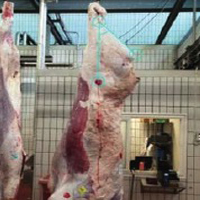Classification of bovine carcasses: New biometric remote sensing tools

Accepted: 30 March 2020
HTML: 18
All claims expressed in this article are solely those of the authors and do not necessarily represent those of their affiliated organizations, or those of the publisher, the editors and the reviewers. Any product that may be evaluated in this article or claim that may be made by its manufacturer is not guaranteed or endorsed by the publisher.
Authors
Slaughtering plants approved by the European Union have specific processes to guarantee that beef carcasses or halfcarcasses, of no less than eight months of age, are provided with health mark and then classified and identified according to the EU carcass classification grid. This classification is based on three criteria: i) Category, ii) Conformation (SEUROP) and iii) Fat Cover (FC). At the end of the classification process each carcass is given a code, consisting of two letters and a number: this operation is called Identification. The aim of our study was to evaluate how the European beef carcass quality classification is determined according to the experience of the personnel involved, then comparing the results with those yielded by the Android platform application. West Systems, through its West- Zootech division, has developed an Android platform application (SEUROP APP) that allows SEUROP and FC classification with a smart-phone. The photo taken with the smart-phone will yield the necessary angular parameters to determine the conformation class depending on the animal’s muscular mass and based on the convexity of some areas on the half-carcass. It also evaluates the ratio between surface of lean tissue and total carcass surface in order to determine the fat cover and complete the classification. The SEUROP APP was able to obtain objective measurements for as much as 84% of the assessments made during the research and development phase.
How to Cite
PAGEPress has chosen to apply the Creative Commons Attribution NonCommercial 4.0 International License (CC BY-NC 4.0) to all manuscripts to be published.

 https://doi.org/10.4081/ijfs.2020.8645
https://doi.org/10.4081/ijfs.2020.8645



